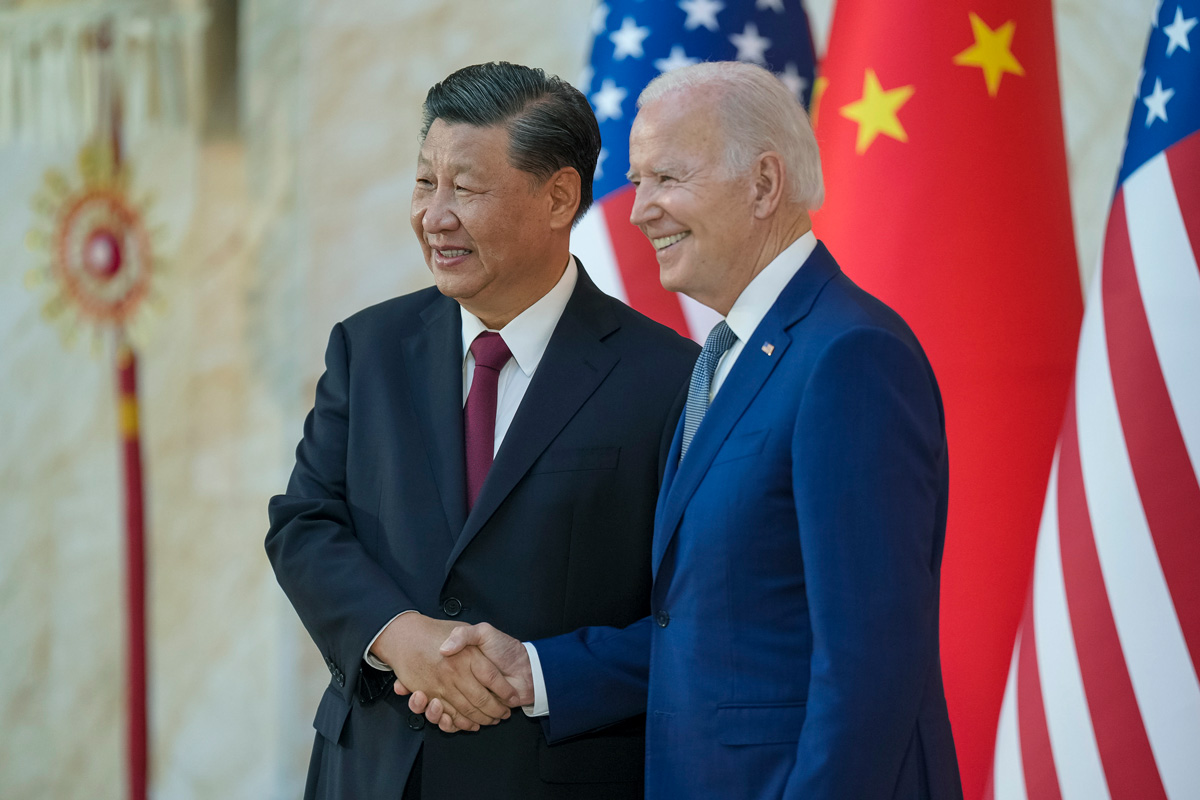
President Joe Biden greets and poses for a photo with Chinese President Xi Jingping at a November 2022 meeting in Indonesia. Official White House Photo by Adam Schultz
Amid continuing geopolitical tensions, climate change remains a key area of collaboration between the United States and China. Ahead of last November’s United Nations Climate Change Conference (COP28), Presidents Biden and Xi reaffirmed their commitment to work jointly—and together with other countries—to address the climate crisis and limit global warming to 1.5 degrees Celsius.
Central to the agreement, now known as the “Sunnylands Statement,” is a commitment to supporting efforts to triple the global production of renewable energy by 2030. That goal, which is the only quantitative target in the agreement, was previously identified as a key target by the International Energy Agency (IEA) and the International Renewable Energy Agency (IREA) and agreed to by G20 leaders during their September 2023 meeting.
A study published today in Environmental Research Letters by UC Berkeley researchers finds that the global growth rate of renewable and low-carbon energy capacity is insufficient to meet this target. Using historical data from IRENA and the IEA, the authors project that China is by far the closest to triple its capacity by 2030, while the five remaining regions—the U.S., European Union, the African continent, Central and South America, and the rest of the world—will fall short.
“The climate crisis is now an emergency of inaction on a true energy transition,” said co-author Daniel Kammen, the James and Katherine Lau Distinguished Professor of Sustainability in the Energy and Resources Group (ERG), the Goldman School of Public Policy, and the Department of Nuclear Engineering. “While some specific policies and the actions of some nations show that a clean, green energy future can be achieved, we must be more systematic, holistic, and aggressive in our actions.”
China’s renewable energy capacity tripled during the last decade, a historic trend projected to continue through 2030. While developers of renewable energy projects in China may face difficulty securing financing and integrating their projects onto the grid, the country regularly surpasses its conservative targets and is more capable of leveraging other policies to facilitate necessary growth.
By comparison, the U.S. would need to significantly raise its renewable ambitions to achieve this target. The authors point to the 2022 Inflation Reduction Act, which authorized $369 billion in new government spending on clean energy and climate mitigation over the next decade, as one successful policy intervention capable of bringing the U.S. closer to its target. While they estimate that IRA-linked renewable energy projects will increase the domestic renewable energy capacity by a factor of 2 or 3, the U.S. will likely need even stronger growth to fulfill its share of a global tripling.
“It’s heartening to see the exponential deployment of the past decade, and 2023 saw by far the biggest gains yet,” said co-author Ari Ball-Burack, a PhD student in ERG. “Moving forward, the U.S. and China have a responsibility to concretely facilitate renewables deployment worldwide.”
Co-author Xi Xi, a graduate student in ERG, notes that the greatest challenge the U.S. and China face will be facilitating and supporting efforts toward tripling renewable energy capacity elsewhere. Renewable energy deployment and power sector expansion are crucial to Africa’s sustainable development goals, yet so much of the continent’s energy development has been historically under-invested. The IEA estimates that more than $200 billion per year of investment by 2030 is required to achieve key energy goals and facilitate a just and inclusive climate transition. Comparable levels of investment are also needed in Central and South America and across the rest of the world.
“The U.S. and China operate within a global context and must proactively acknowledge and incorporate global perspectives, particularly from the Global South, and actively contribute to climate mitigation efforts worldwide,” she said.
The researchers assert that although the two countries’ joint declaration sets an optimistic framework with which to build lasting international climate cooperation, much work remains to limit warming to 1.5 degrees Celsius. They propose four actionable steps to ensure the Sunnylands tripling commitment is met:
- The commitments must transform into delivered funds, with actionable plans to assemble and distribute funds committed to addressing challenges of climate mitigation and adaptation.
- Subnational and informal collaborations between the two countries and the rest of the world should accelerate technology and knowledge transfer to provide appropriate, effective, and efficient solutions.
- The two countries should prioritize collaboration over competition. A competitive mindset could hinder the development of globalized supply chains, significantly increasing renewables costs.
- Fostering an inclusive and collaborative climate discourse internationally is crucial for a speedy, just transition toward the net zero world and can facilitate and accelerate reforms in multilateral institutions to ensure just and viable institutional and financial mechanisms for renewables development in the Global South.
Read their full analysis in Environmental Research Letters.
